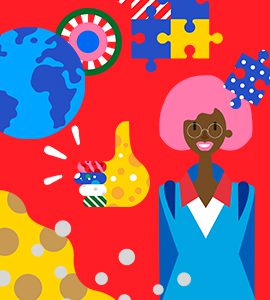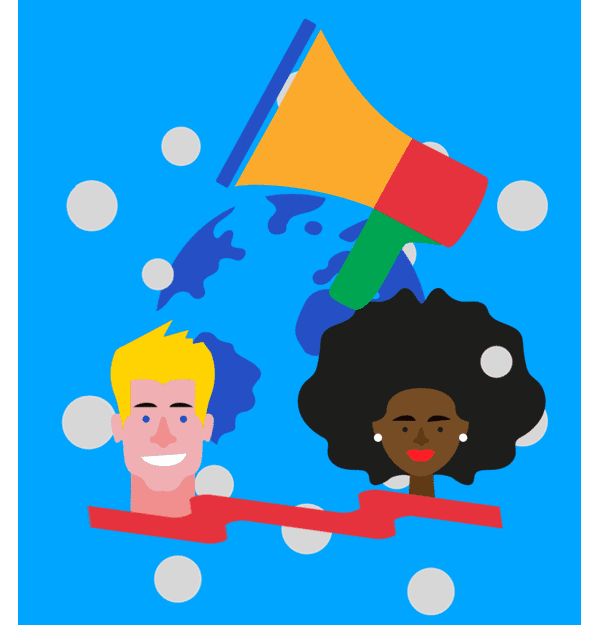Creating the right content and enriching it with the proper images can become challenging when targeting international audiences. It’s not easy to find visuals that break the cultural barrier and help people speaking different languages relate to your message. That’s because what makes a nice picture for you might not be enough to encourage engagement and trigger a positive response from your multilingual audiences.
Our brains can identify images seen for as little as 13 milliseconds. That’s the speed with which the brain can find the concept in an image and process it. Sure, if the visual content you share shows aspects of life people aren’t familiar with, you’re less likely to create a memorable experience for your audiences.
Visual content for an international public must be diverse and inclusive because what might seem like a nice picture for an American audience can easily confuse an Eastern one. So, how do you find international images that people can relate to regardless of their language or nationality?
You’ll probably have to create them instead of relying on stock images and biased visuals everyone else has used for years. Three cost-effective ways are collage images, user-generated content, and local art.
Combine Images to Convey Your Message
Sometimes, a collage image might be the answer to addressing international audiences. People like images that illustrate products as they’re used in real-life situations, so bringing together multiple images to highlight diversity can help you communicate value more effectively.
E-commerce stores and fashion brands like Burberry or Urban Outfitters use collage images to boost email marketing revenue and encourage engagement. It’s an effective way to highlight diversity and unity simultaneously, with a powerful impact on the viewer.
With this method, you communicate your brand with multiple stimuli, so you need to pay attention to details and ensure that all the elements add value to the new image.
It’s a complex way to enrich your content, but creating a high-quality picture with this method isn’t easy. Many features should align to ensure balance, from composition to contrast to colors and patterns, so working with professional designers is necessary.
Besides keeping the images on brand, you want to make sure your nice pictures appeal to global audiences. You need cultural insights and a deep understanding of what triggers your international audience to communicate your message effectively with pictures.
Authentic Is Better than Perfect
A nice picture isn’t necessarily the perfect shot when you target an international audience. Authenticity is more likely to align with diversion and inclusion. It means that you should provide more space for real-life images that help people feel that your content has been created specifically for them.
In this context, user-generated images can help you achieve this goal better than over-edited visuals. That’s because people build special memories when taking these pictures, making it easy for you to communicate emotions.
If you want to represent people accurately with authentic images, you need to focus on:
- Diversity. Make sure your images highlight characteristics and experiences that embrace the differences between segments of your audience, with attention to cultural details that might influence perception.
- Inclusion. Your images should create a safe space for all cultures and encourage people to respect cultural differences.
And the easiest way to get there is by incorporating user-generated images in your international marketing campaigns. The good news is that this strategy can impact your revenue, as buyers are 2.4 times more likely to view user-generated content as authentic than brand content.
Here, too, cultural insights play an essential role in connecting with your audience. Picking the right images to endorse must consider the audience’s expectations and values. This way, you ensure that your brand doesn’t promote offensive or controversial content in an inappropriate context.
Use Local Art to Differentiate Your Brand in Global Markets
Global brands have been collaborating with famous artists for some time now. You can make a similar impact with a small budget if you focus on local art. It’s a way to communicate your brand and reach new audiences while supporting local artists.
This strategy has a cultural significance and can make your marketing messages original and different from local and global competitors. Plus, it can become a cost-effective way to capture and maintain the attention of international audiences to consolidate brand awareness and optimize conversions.
Moreover, local artists and photographers are more likely to deliver high-quality images that speak to your audience’s hearts. They have the cultural insights that make them trustworthy advisors for your global brand, so you enrich your content with excellent pictures that are inclusive and respectful.
A Nice Picture Doesn’t Leverage Stereotypes
Stereotyping can turn a nice picture into unappealing content that distracts from the purpose of your communication or even offends people. Image choices should consider diversity and cultural differences with empathy and focus on the target audience.
It all starts with understanding the people you talk to beyond what you think they might want or like. Elegant men who buy luxury cars, happy women shopping, or immigrant women who wear a hijab are among the most common stereotypes marketers and content creators use to enrich their messages. None of them reflects reality, and global market research has repeatedly proven stereotypes, especially gender-related, are still too present in advertising and marketing.
If you want people to relate to your content, give them images that reflect who they are in their everyday life.
When you target local audiences, the easiest way to identify what makes a nice picture for your audience is through research. Go to your local competitors’ websites and see what images they’re using to enrich content. Review at least 4 to 5 sites to learn to recognize patterns and common symbols people are used to seeing online.
If you still have doubts, go to social media like Instagram and Pinterest to get more insights into what images appeal to your audience.
If you want a one-size-fits-all image for a global brand campaign, think of the multiple audiences you’re targeting and identify the elements all these markets have in common. Then, find a way to celebrate the diversity of the most significant segments so more people can relate to your message.
Summary
When creating visual content for international audiences, you want images and photography that people with different cultural backgrounds can relate to. A nice picture communicates emotion and overcomes cultural and language barriers. It means you’ll have to step away from stock photos and come up with original, authentic alternatives that reflect the diversity of your global audience and celebrate the richness of multiculturalism.








